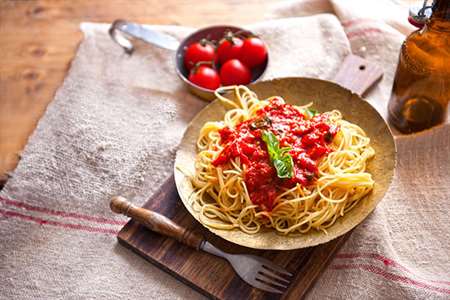
Too many times, people are walking down the grocery aisles in search of the healthiest products. When it comes to pasta, there is a plethora of versions and variations. Commonly, individuals try to choose whole wheat pastas over white pastas. Additionally, when "gluten" surfaced and became commonly misunderstood, reaching for "gluten-free" products developed into the new health trend. However, is gluten free pasta healthier? And is whole wheat pasta better for you?
The Noodling Truth
Yes, pasta is a carbohydrate source and no, carbohydrates are not bad for you unlike common belief. When choosing pasta, it is more important to pay attention to the nutrition facts and ingredient labels rather than making irrational decisions based on marketing strategies and buzzwords. When it really comes down to it, pasta is a simple product. If ingredients start looking a little sketchy and unrecognizable, stray away from it.
To get the most bang for your nutritional buck, choose whole grain and wheat products. Although white pasta is not necessarily the bad guy, wheat products offer a little more than what white products can. In reality, white pastas are stripped down or bleached versions of wheat pastas. Although some wheat products may contain extra calories, their nutrient content is a worthy compromise.
The buzzword of "gluten" cannot be reiterated enough. Just because "gluten-free" is slapped on a noodle box, does not automate it to being healthier. Some pastas that are gluten-free may even contain a higher carbohydrate content. Gluten truly needs to be avoided by those with Celiac disease or a severe gluten sensitivity. Gluten-free pastas and gluten-free alternatives are available for individuals wanting that pasta fix without harming their bodies.
Gluten-Free Alternatives
Zucchini Noodles
If reaching for the "gluten-free" pasta was in hopes to decrease carbohydrate content, zucchini noodles are right for you. Additionally, veggie noodles are automatic gluten-free themselves, just be weary on toppings and sauces added. Not only are they low in calories, but packed with nutrients and fiber.
Spaghetti Squash
A spaghetti squash is not only low in calorie and carbs like zucchini noodles, but packed with vitamins A and C. Scraping the flesh out of a cooked spaghetti squash provides a noodle-like result and will take on any flavor desired. Pesto sauce filled with fresh herbs and olive oil will accelerate the nutritional profile even further.
Rice
This beloved little grain has been a longtime staple and not just a health trend. Brown rice is bursting with B vitamins and fiber. If desiring more of a pasta noodle shape, brown rice pasta exists and is a valuable noodle choice.
Quinoa
Quinoa has had tremendous growth over the past years, even incorporated into restaurant menus. Quinoa is a gluten-free alternative and packed with nutrients. It is an excellent source of protein and provides iron, magnesium, vitamin E, potassium, and fiber. Although the shape is not similar to a pasta noodle, it is versatile and can be added to salads, meatballs, and shrimp and veggie stirs.
Ultimately when choosing pastas, aim for simple ingredients and whole grains. Be aware of the nutrition label and don't fall into the "gluten-free means healthy" trap. If gluten-free is needed, you can confirm its safety further with a product label. Stick to portion and serving sizes to avoid the easily achieved overeating of pasta.







